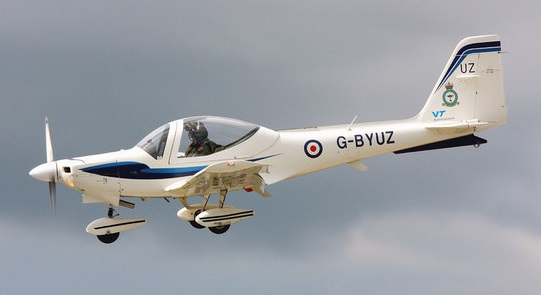Flying
Your ATC flying career will probably begin in the Grob Tutor at No 6 AEF Air Experience Flight located at RAF Benson. Squadrons are allocated a number of places each year at their AEF, and additionally AEF is normally included on the summer camp programme. With an RAF or RAFVR(T) pilot at the controls you will be introduced to the effects of the controls on the aircraft and, if you wish, you will probably have the opportunity to take the controls yourself. As you become more experiences you will get the opportunity to experience aerobatics, initially you will follow the pilot through on the controls, lightly placing your hands and feet on the control column and rudder pedals to get a feel for the control inputs required to perform the manoeuvre, then you may have the chance to fly the aircraft in an aerobatic manoeuvre yourself.
Grob 115E Tutor
The Grob 115E, known by the RAF as the Tutor, is used for Elementary Flying Training by the 12 Air Experience Flights, initial flying training by the RAF at Cranwell and at University Air Squadrons throughout the UK.
The Grob G 115 is an advanced general aviation fixed-wing aircraft, primarily used for flight training. It is built in Germany by Grob Aircraft (Grob Aerospace before January 2009). The E variant with a 3-blade variable pitch propeller is in Royal Air Force service for initial flying training.
It is a single-engined low-wing monoplane with a fixed tricycle undercarriage, Short nose, large glazed area cabin and two seats side-by-side.
Other Flying opportunities
Cadets will also have the opportunity to in current service aircraft, such as the Chinook, Voyager or Puma. These flights normally occur during summer camp, but may be arranged locally by squadron commanders and may include flights as a passenger in a fast jet, onboard a tanker aircraft on a refueling sortie or as a supernumerary crew member on a transport aircraft or helicopter. It is not uncommon for cadets to get an overseas visit as part of an opportunity flight. In additonal to these flights, cadets can also apply for a microlight course, flying scholarship or pilot navigation scheme. For the real thrill seeker, the Air Cadets also has opportunities to complete a parachute training course and parachute jump.
Flying Scholarship
The Flying Scholarship award is presented each year as a thank you to members of the ACO
(which includes the Air Training Corps and the Combined Cadet Force), GVCAC and Air
Scouts/Air Explorer Scouts for their continuous support to the RAF Association.
Winning candidates are rewarded with a course of 35 hours flight training in a light aircraft, and the course covers all or part of the tuition needed to obtain a National Private Pilot Licence (NPPL). Four runners-up receive 12 hours training each.
Pilot Navigation Scheme
Cadets may also apply for the Air Cadet Pilot Navigation Scheme, which provides 8 hours air navigation training over a fourteen day period at an AEF in the Grob Tutor aircraft. There is a significant amount of ground based planning to be done prior to the airborne navigation exercises. To be eligible to apply cadets must be aged 16 or older and gave passed the Air Navigation section of the cadet training syllabus.
Microlight course
This flying training course provides up to ten hours flying to the first solo standard in a microlight aircraft at an RAF Microlight Club such as located at RAF Halton.
Parachute course
Cadets can apply for a parachute course at RAF Weston-on-the-Green, where they will undertake extensive ground training. Once they are considered proficient they will have one static line descent from an aircraft at a height of approximately 3500 feet (subject to weather).
The course is not intended provide any parachuting qualifications (for this you will have to complete many more descents), however it is a good starting place for anyone wishing to take the sport further.











